Australia and Saudi Arabia: Energy and Water Sustainability Report
VerifiedAdded on 2020/04/01
|10
|2487
|39
Report
AI Summary
This report provides a comparative analysis of energy and water sustainability in Australia and Saudi Arabia. It begins by introducing the importance of sustainability in the face of climate change and resource depletion. The report then delves into the specific strategies adopted by both countries. Australia's efforts include investments in renewable energy through schemes and agencies, energy efficiency programs, and water management policies like the Water Services Act. Saudi Arabia, facing water scarcity, relies heavily on desalination and has established agencies and policies to manage water resources and promote energy efficiency, including investment in renewable energy. The report compares the approaches of both countries, highlighting Australia's emphasis on renewable energy and Saudi Arabia's reliance on desalination. The analysis also considers the roles of government, NGOs, and the private sector. The report concludes by emphasizing the importance of sustainability and the need for both countries to adapt and improve their strategies to address the challenges of energy and water scarcity.
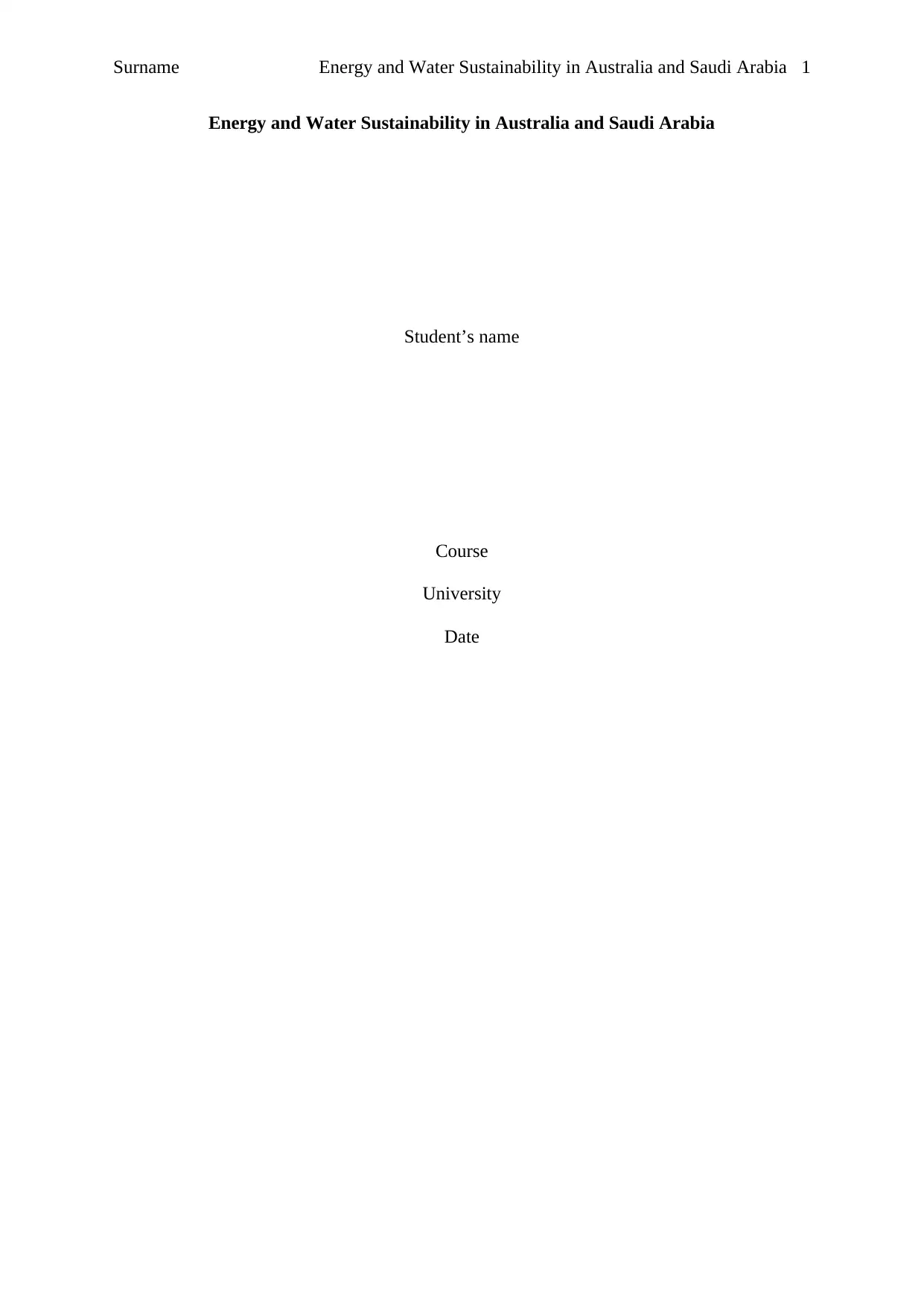
Surname Energy and Water Sustainability in Australia and Saudi Arabia 1
Energy and Water Sustainability in Australia and Saudi Arabia
Student’s name
Course
University
Date
Energy and Water Sustainability in Australia and Saudi Arabia
Student’s name
Course
University
Date
Paraphrase This Document
Need a fresh take? Get an instant paraphrase of this document with our AI Paraphraser
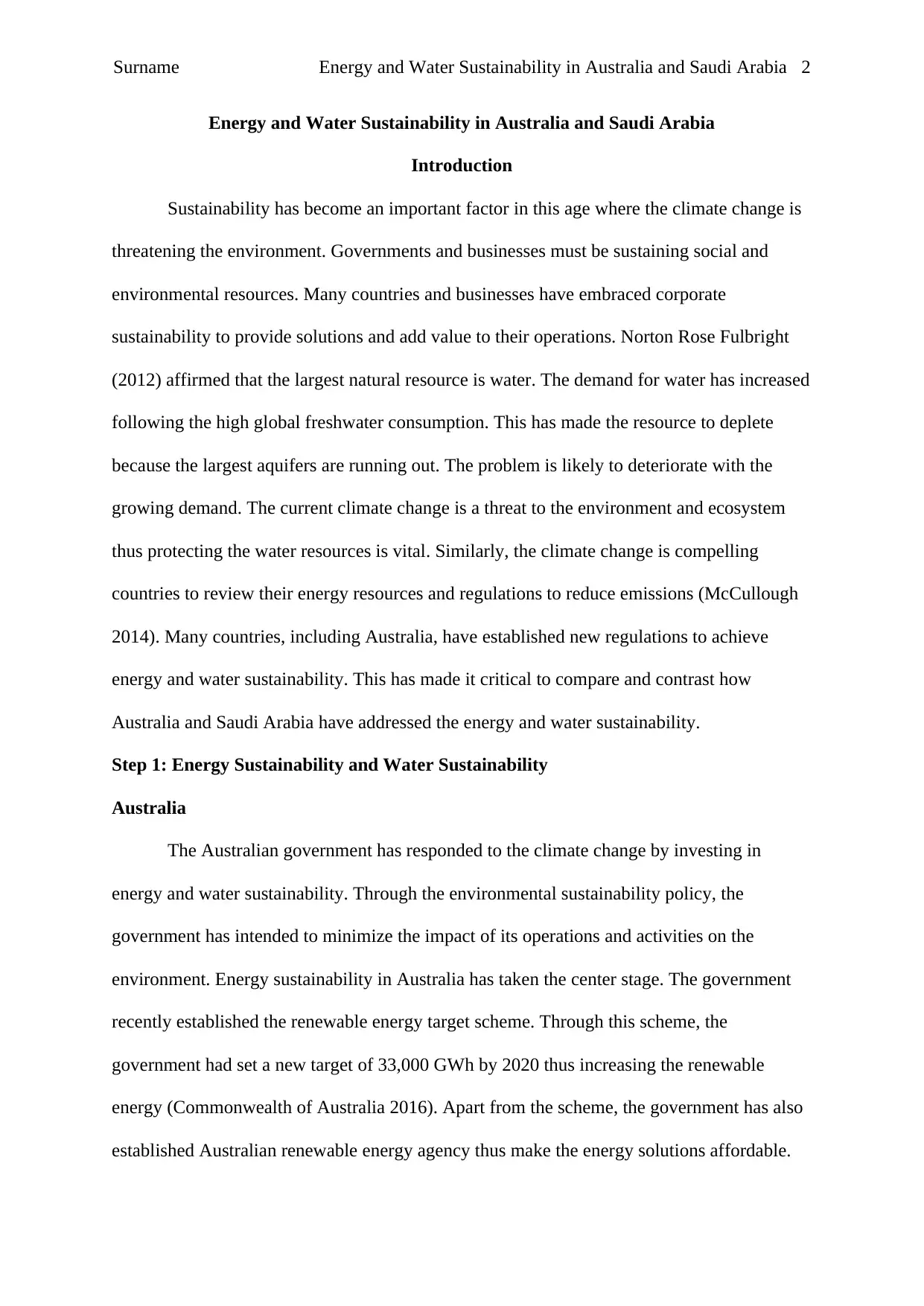
Surname Energy and Water Sustainability in Australia and Saudi Arabia 2
Energy and Water Sustainability in Australia and Saudi Arabia
Introduction
Sustainability has become an important factor in this age where the climate change is
threatening the environment. Governments and businesses must be sustaining social and
environmental resources. Many countries and businesses have embraced corporate
sustainability to provide solutions and add value to their operations. Norton Rose Fulbright
(2012) affirmed that the largest natural resource is water. The demand for water has increased
following the high global freshwater consumption. This has made the resource to deplete
because the largest aquifers are running out. The problem is likely to deteriorate with the
growing demand. The current climate change is a threat to the environment and ecosystem
thus protecting the water resources is vital. Similarly, the climate change is compelling
countries to review their energy resources and regulations to reduce emissions (McCullough
2014). Many countries, including Australia, have established new regulations to achieve
energy and water sustainability. This has made it critical to compare and contrast how
Australia and Saudi Arabia have addressed the energy and water sustainability.
Step 1: Energy Sustainability and Water Sustainability
Australia
The Australian government has responded to the climate change by investing in
energy and water sustainability. Through the environmental sustainability policy, the
government has intended to minimize the impact of its operations and activities on the
environment. Energy sustainability in Australia has taken the center stage. The government
recently established the renewable energy target scheme. Through this scheme, the
government had set a new target of 33,000 GWh by 2020 thus increasing the renewable
energy (Commonwealth of Australia 2016). Apart from the scheme, the government has also
established Australian renewable energy agency thus make the energy solutions affordable.
Energy and Water Sustainability in Australia and Saudi Arabia
Introduction
Sustainability has become an important factor in this age where the climate change is
threatening the environment. Governments and businesses must be sustaining social and
environmental resources. Many countries and businesses have embraced corporate
sustainability to provide solutions and add value to their operations. Norton Rose Fulbright
(2012) affirmed that the largest natural resource is water. The demand for water has increased
following the high global freshwater consumption. This has made the resource to deplete
because the largest aquifers are running out. The problem is likely to deteriorate with the
growing demand. The current climate change is a threat to the environment and ecosystem
thus protecting the water resources is vital. Similarly, the climate change is compelling
countries to review their energy resources and regulations to reduce emissions (McCullough
2014). Many countries, including Australia, have established new regulations to achieve
energy and water sustainability. This has made it critical to compare and contrast how
Australia and Saudi Arabia have addressed the energy and water sustainability.
Step 1: Energy Sustainability and Water Sustainability
Australia
The Australian government has responded to the climate change by investing in
energy and water sustainability. Through the environmental sustainability policy, the
government has intended to minimize the impact of its operations and activities on the
environment. Energy sustainability in Australia has taken the center stage. The government
recently established the renewable energy target scheme. Through this scheme, the
government had set a new target of 33,000 GWh by 2020 thus increasing the renewable
energy (Commonwealth of Australia 2016). Apart from the scheme, the government has also
established Australian renewable energy agency thus make the energy solutions affordable.
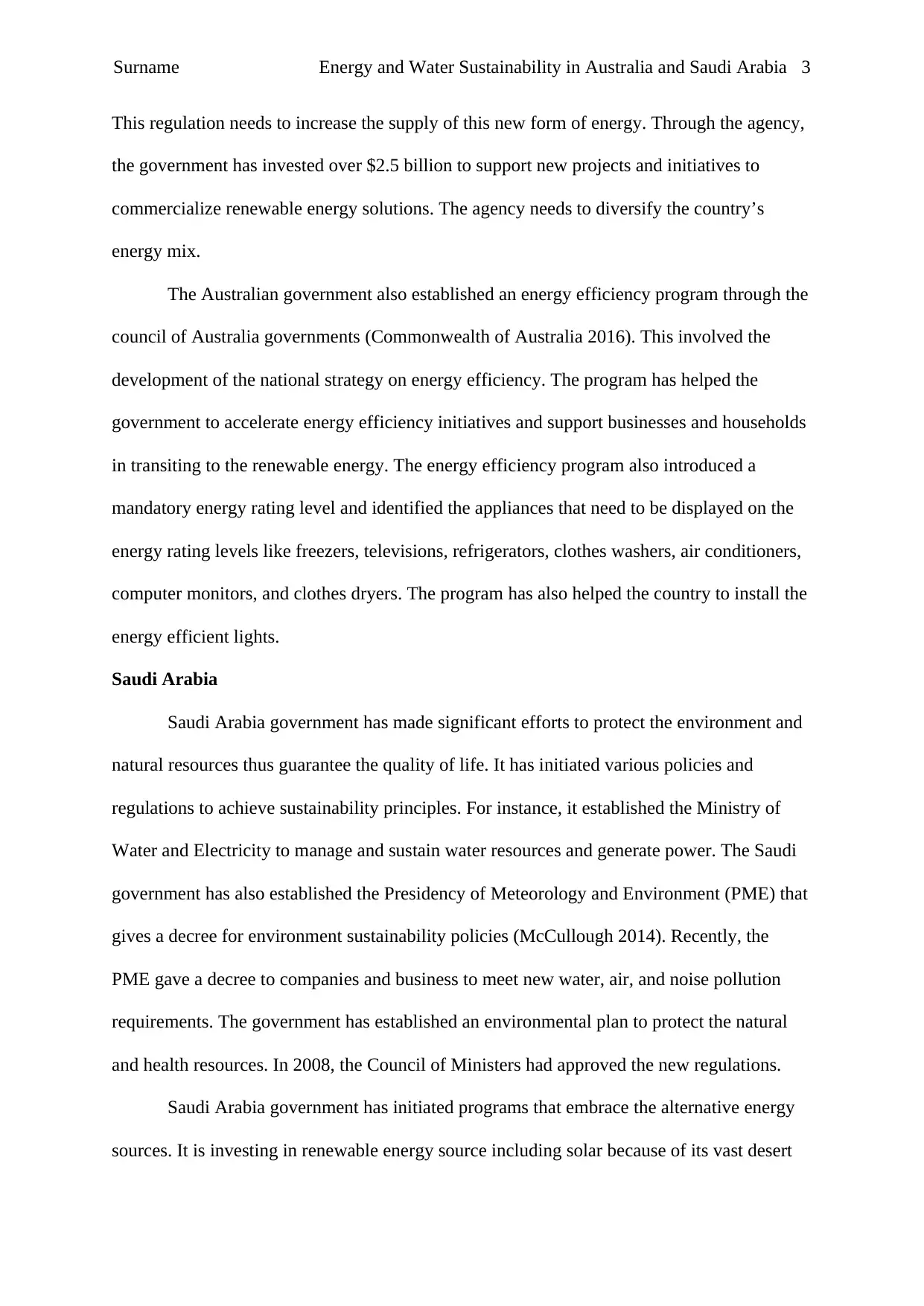
Surname Energy and Water Sustainability in Australia and Saudi Arabia 3
This regulation needs to increase the supply of this new form of energy. Through the agency,
the government has invested over $2.5 billion to support new projects and initiatives to
commercialize renewable energy solutions. The agency needs to diversify the country’s
energy mix.
The Australian government also established an energy efficiency program through the
council of Australia governments (Commonwealth of Australia 2016). This involved the
development of the national strategy on energy efficiency. The program has helped the
government to accelerate energy efficiency initiatives and support businesses and households
in transiting to the renewable energy. The energy efficiency program also introduced a
mandatory energy rating level and identified the appliances that need to be displayed on the
energy rating levels like freezers, televisions, refrigerators, clothes washers, air conditioners,
computer monitors, and clothes dryers. The program has also helped the country to install the
energy efficient lights.
Saudi Arabia
Saudi Arabia government has made significant efforts to protect the environment and
natural resources thus guarantee the quality of life. It has initiated various policies and
regulations to achieve sustainability principles. For instance, it established the Ministry of
Water and Electricity to manage and sustain water resources and generate power. The Saudi
government has also established the Presidency of Meteorology and Environment (PME) that
gives a decree for environment sustainability policies (McCullough 2014). Recently, the
PME gave a decree to companies and business to meet new water, air, and noise pollution
requirements. The government has established an environmental plan to protect the natural
and health resources. In 2008, the Council of Ministers had approved the new regulations.
Saudi Arabia government has initiated programs that embrace the alternative energy
sources. It is investing in renewable energy source including solar because of its vast desert
This regulation needs to increase the supply of this new form of energy. Through the agency,
the government has invested over $2.5 billion to support new projects and initiatives to
commercialize renewable energy solutions. The agency needs to diversify the country’s
energy mix.
The Australian government also established an energy efficiency program through the
council of Australia governments (Commonwealth of Australia 2016). This involved the
development of the national strategy on energy efficiency. The program has helped the
government to accelerate energy efficiency initiatives and support businesses and households
in transiting to the renewable energy. The energy efficiency program also introduced a
mandatory energy rating level and identified the appliances that need to be displayed on the
energy rating levels like freezers, televisions, refrigerators, clothes washers, air conditioners,
computer monitors, and clothes dryers. The program has also helped the country to install the
energy efficient lights.
Saudi Arabia
Saudi Arabia government has made significant efforts to protect the environment and
natural resources thus guarantee the quality of life. It has initiated various policies and
regulations to achieve sustainability principles. For instance, it established the Ministry of
Water and Electricity to manage and sustain water resources and generate power. The Saudi
government has also established the Presidency of Meteorology and Environment (PME) that
gives a decree for environment sustainability policies (McCullough 2014). Recently, the
PME gave a decree to companies and business to meet new water, air, and noise pollution
requirements. The government has established an environmental plan to protect the natural
and health resources. In 2008, the Council of Ministers had approved the new regulations.
Saudi Arabia government has initiated programs that embrace the alternative energy
sources. It is investing in renewable energy source including solar because of its vast desert
⊘ This is a preview!⊘
Do you want full access?
Subscribe today to unlock all pages.

Trusted by 1+ million students worldwide
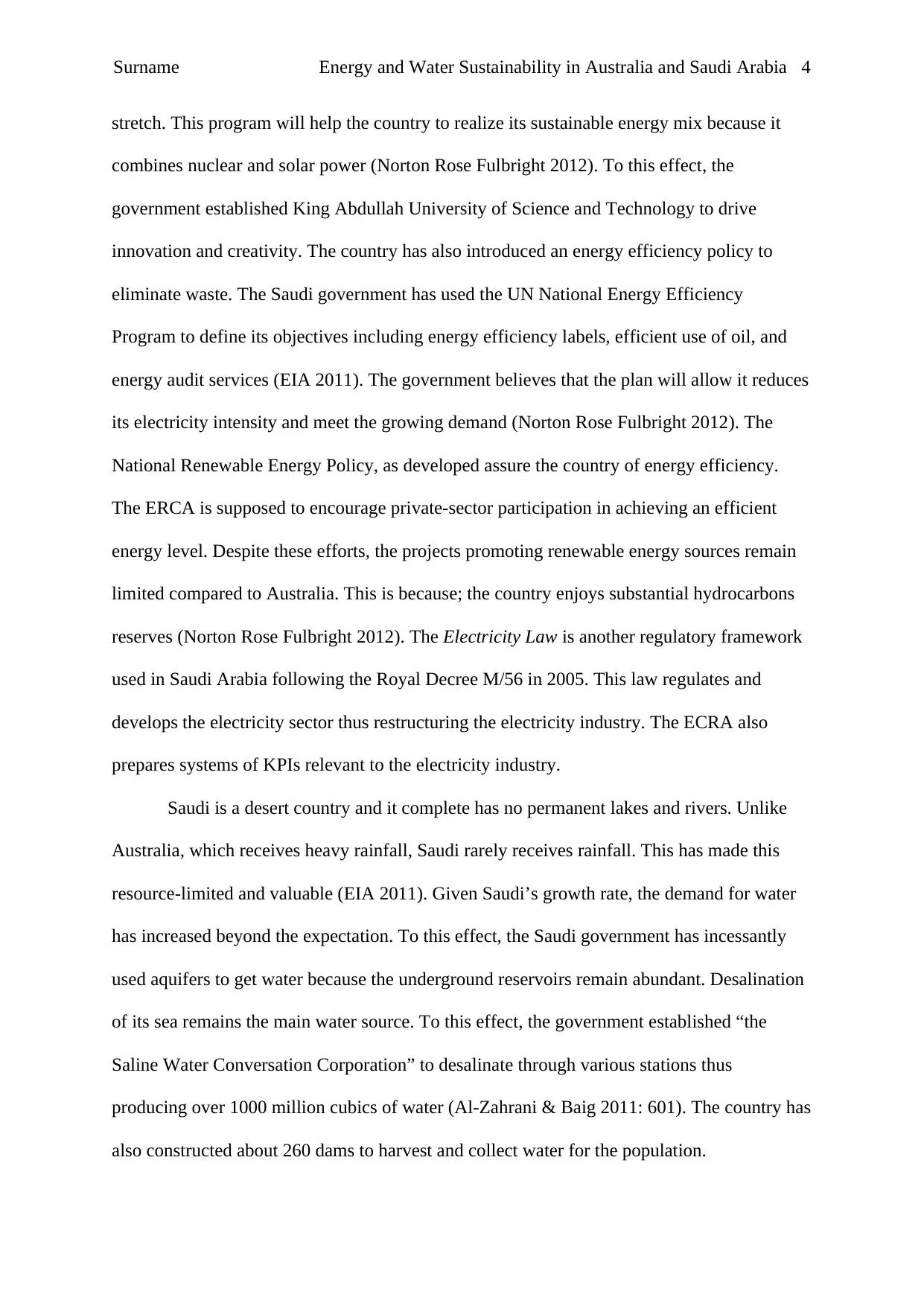
Surname Energy and Water Sustainability in Australia and Saudi Arabia 4
stretch. This program will help the country to realize its sustainable energy mix because it
combines nuclear and solar power (Norton Rose Fulbright 2012). To this effect, the
government established King Abdullah University of Science and Technology to drive
innovation and creativity. The country has also introduced an energy efficiency policy to
eliminate waste. The Saudi government has used the UN National Energy Efficiency
Program to define its objectives including energy efficiency labels, efficient use of oil, and
energy audit services (EIA 2011). The government believes that the plan will allow it reduces
its electricity intensity and meet the growing demand (Norton Rose Fulbright 2012). The
National Renewable Energy Policy, as developed assure the country of energy efficiency.
The ERCA is supposed to encourage private-sector participation in achieving an efficient
energy level. Despite these efforts, the projects promoting renewable energy sources remain
limited compared to Australia. This is because; the country enjoys substantial hydrocarbons
reserves (Norton Rose Fulbright 2012). The Electricity Law is another regulatory framework
used in Saudi Arabia following the Royal Decree M/56 in 2005. This law regulates and
develops the electricity sector thus restructuring the electricity industry. The ECRA also
prepares systems of KPIs relevant to the electricity industry.
Saudi is a desert country and it complete has no permanent lakes and rivers. Unlike
Australia, which receives heavy rainfall, Saudi rarely receives rainfall. This has made this
resource-limited and valuable (EIA 2011). Given Saudi’s growth rate, the demand for water
has increased beyond the expectation. To this effect, the Saudi government has incessantly
used aquifers to get water because the underground reservoirs remain abundant. Desalination
of its sea remains the main water source. To this effect, the government established “the
Saline Water Conversation Corporation” to desalinate through various stations thus
producing over 1000 million cubics of water (Al-Zahrani & Baig 2011: 601). The country has
also constructed about 260 dams to harvest and collect water for the population.
stretch. This program will help the country to realize its sustainable energy mix because it
combines nuclear and solar power (Norton Rose Fulbright 2012). To this effect, the
government established King Abdullah University of Science and Technology to drive
innovation and creativity. The country has also introduced an energy efficiency policy to
eliminate waste. The Saudi government has used the UN National Energy Efficiency
Program to define its objectives including energy efficiency labels, efficient use of oil, and
energy audit services (EIA 2011). The government believes that the plan will allow it reduces
its electricity intensity and meet the growing demand (Norton Rose Fulbright 2012). The
National Renewable Energy Policy, as developed assure the country of energy efficiency.
The ERCA is supposed to encourage private-sector participation in achieving an efficient
energy level. Despite these efforts, the projects promoting renewable energy sources remain
limited compared to Australia. This is because; the country enjoys substantial hydrocarbons
reserves (Norton Rose Fulbright 2012). The Electricity Law is another regulatory framework
used in Saudi Arabia following the Royal Decree M/56 in 2005. This law regulates and
develops the electricity sector thus restructuring the electricity industry. The ECRA also
prepares systems of KPIs relevant to the electricity industry.
Saudi is a desert country and it complete has no permanent lakes and rivers. Unlike
Australia, which receives heavy rainfall, Saudi rarely receives rainfall. This has made this
resource-limited and valuable (EIA 2011). Given Saudi’s growth rate, the demand for water
has increased beyond the expectation. To this effect, the Saudi government has incessantly
used aquifers to get water because the underground reservoirs remain abundant. Desalination
of its sea remains the main water source. To this effect, the government established “the
Saline Water Conversation Corporation” to desalinate through various stations thus
producing over 1000 million cubics of water (Al-Zahrani & Baig 2011: 601). The country has
also constructed about 260 dams to harvest and collect water for the population.
Paraphrase This Document
Need a fresh take? Get an instant paraphrase of this document with our AI Paraphraser
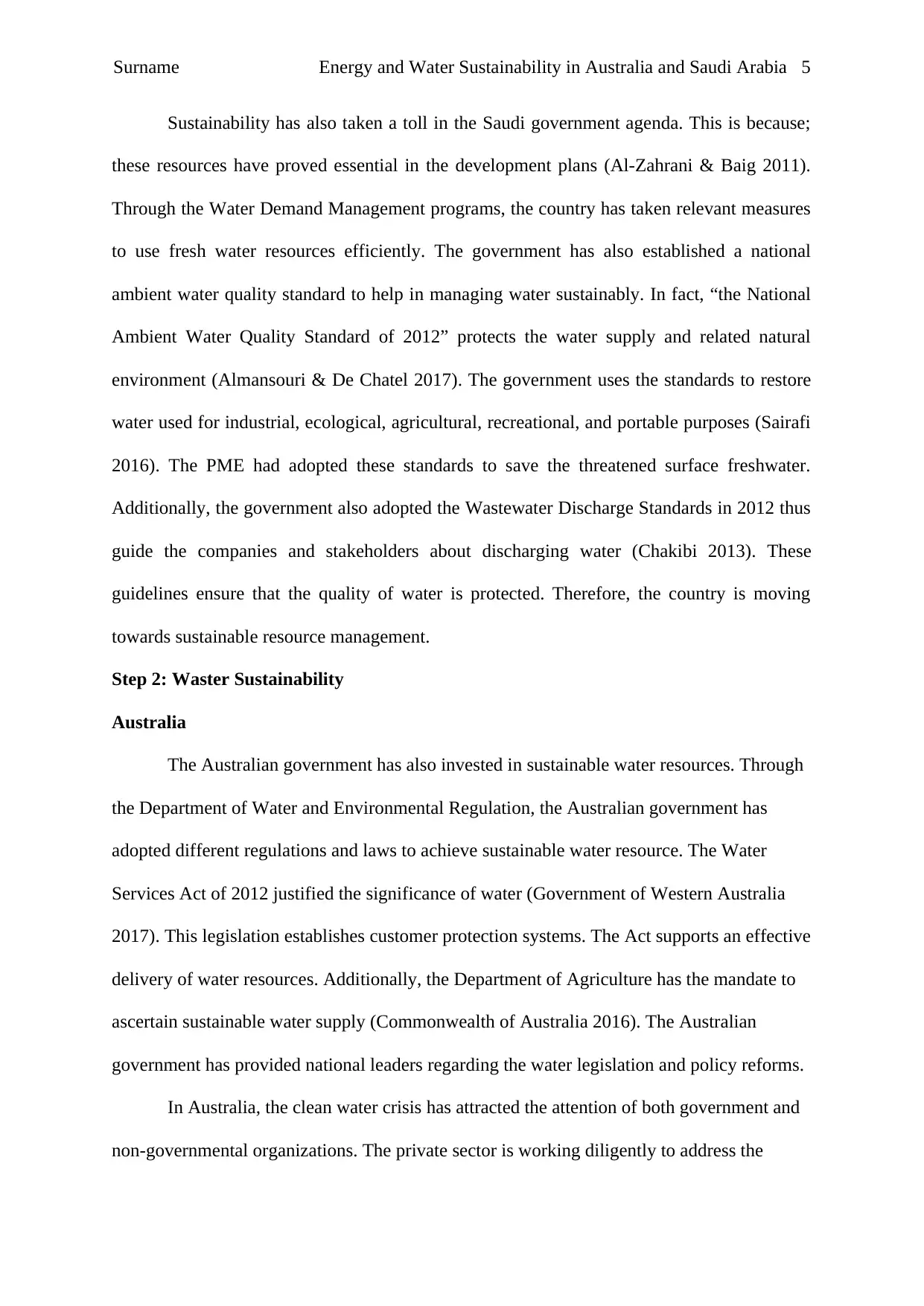
Surname Energy and Water Sustainability in Australia and Saudi Arabia 5
Sustainability has also taken a toll in the Saudi government agenda. This is because;
these resources have proved essential in the development plans (Al-Zahrani & Baig 2011).
Through the Water Demand Management programs, the country has taken relevant measures
to use fresh water resources efficiently. The government has also established a national
ambient water quality standard to help in managing water sustainably. In fact, “the National
Ambient Water Quality Standard of 2012” protects the water supply and related natural
environment (Almansouri & De Chatel 2017). The government uses the standards to restore
water used for industrial, ecological, agricultural, recreational, and portable purposes (Sairafi
2016). The PME had adopted these standards to save the threatened surface freshwater.
Additionally, the government also adopted the Wastewater Discharge Standards in 2012 thus
guide the companies and stakeholders about discharging water (Chakibi 2013). These
guidelines ensure that the quality of water is protected. Therefore, the country is moving
towards sustainable resource management.
Step 2: Waster Sustainability
Australia
The Australian government has also invested in sustainable water resources. Through
the Department of Water and Environmental Regulation, the Australian government has
adopted different regulations and laws to achieve sustainable water resource. The Water
Services Act of 2012 justified the significance of water (Government of Western Australia
2017). This legislation establishes customer protection systems. The Act supports an effective
delivery of water resources. Additionally, the Department of Agriculture has the mandate to
ascertain sustainable water supply (Commonwealth of Australia 2016). The Australian
government has provided national leaders regarding the water legislation and policy reforms.
In Australia, the clean water crisis has attracted the attention of both government and
non-governmental organizations. The private sector is working diligently to address the
Sustainability has also taken a toll in the Saudi government agenda. This is because;
these resources have proved essential in the development plans (Al-Zahrani & Baig 2011).
Through the Water Demand Management programs, the country has taken relevant measures
to use fresh water resources efficiently. The government has also established a national
ambient water quality standard to help in managing water sustainably. In fact, “the National
Ambient Water Quality Standard of 2012” protects the water supply and related natural
environment (Almansouri & De Chatel 2017). The government uses the standards to restore
water used for industrial, ecological, agricultural, recreational, and portable purposes (Sairafi
2016). The PME had adopted these standards to save the threatened surface freshwater.
Additionally, the government also adopted the Wastewater Discharge Standards in 2012 thus
guide the companies and stakeholders about discharging water (Chakibi 2013). These
guidelines ensure that the quality of water is protected. Therefore, the country is moving
towards sustainable resource management.
Step 2: Waster Sustainability
Australia
The Australian government has also invested in sustainable water resources. Through
the Department of Water and Environmental Regulation, the Australian government has
adopted different regulations and laws to achieve sustainable water resource. The Water
Services Act of 2012 justified the significance of water (Government of Western Australia
2017). This legislation establishes customer protection systems. The Act supports an effective
delivery of water resources. Additionally, the Department of Agriculture has the mandate to
ascertain sustainable water supply (Commonwealth of Australia 2016). The Australian
government has provided national leaders regarding the water legislation and policy reforms.
In Australia, the clean water crisis has attracted the attention of both government and
non-governmental organizations. The private sector is working diligently to address the
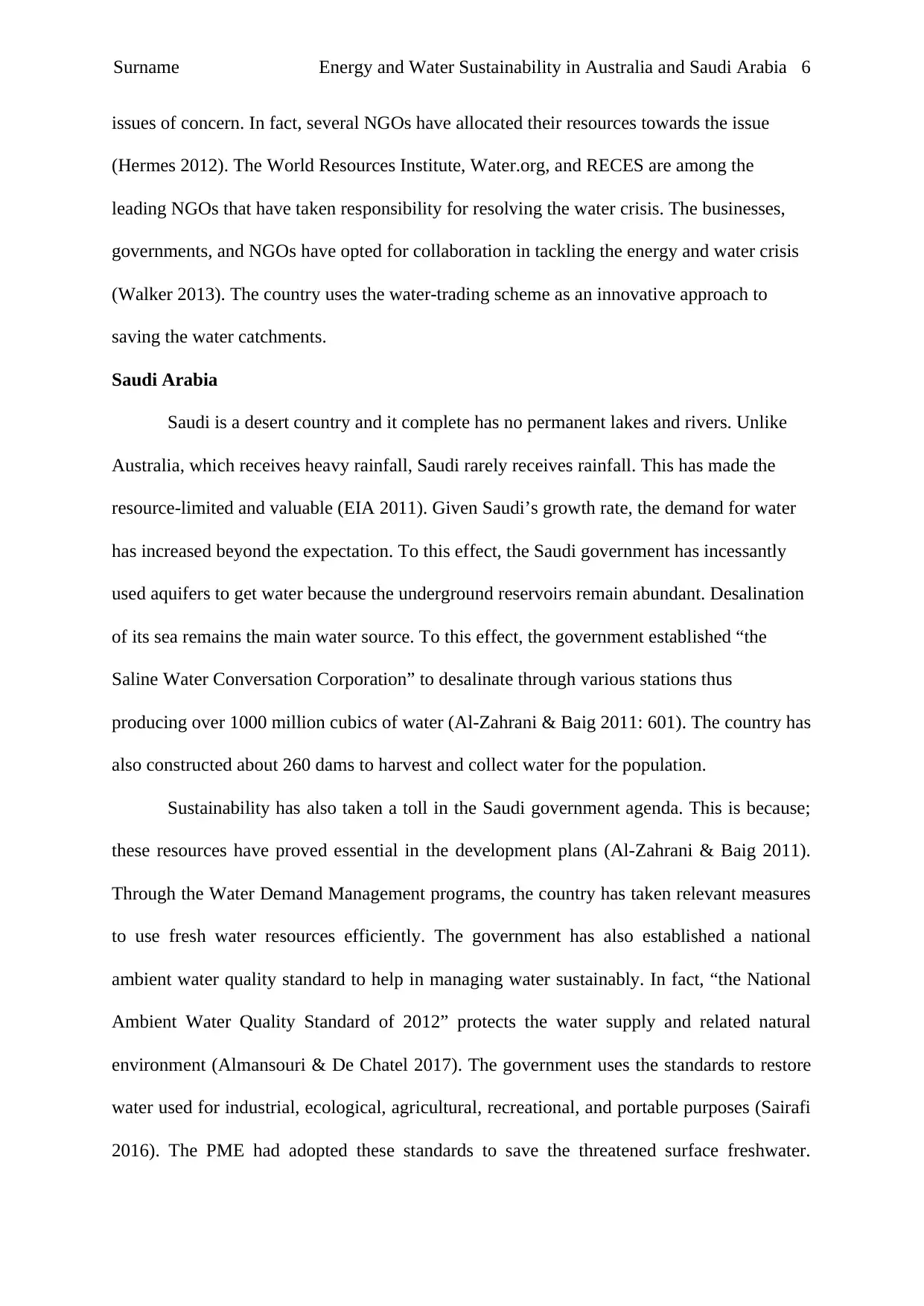
Surname Energy and Water Sustainability in Australia and Saudi Arabia 6
issues of concern. In fact, several NGOs have allocated their resources towards the issue
(Hermes 2012). The World Resources Institute, Water.org, and RECES are among the
leading NGOs that have taken responsibility for resolving the water crisis. The businesses,
governments, and NGOs have opted for collaboration in tackling the energy and water crisis
(Walker 2013). The country uses the water-trading scheme as an innovative approach to
saving the water catchments.
Saudi Arabia
Saudi is a desert country and it complete has no permanent lakes and rivers. Unlike
Australia, which receives heavy rainfall, Saudi rarely receives rainfall. This has made the
resource-limited and valuable (EIA 2011). Given Saudi’s growth rate, the demand for water
has increased beyond the expectation. To this effect, the Saudi government has incessantly
used aquifers to get water because the underground reservoirs remain abundant. Desalination
of its sea remains the main water source. To this effect, the government established “the
Saline Water Conversation Corporation” to desalinate through various stations thus
producing over 1000 million cubics of water (Al-Zahrani & Baig 2011: 601). The country has
also constructed about 260 dams to harvest and collect water for the population.
Sustainability has also taken a toll in the Saudi government agenda. This is because;
these resources have proved essential in the development plans (Al-Zahrani & Baig 2011).
Through the Water Demand Management programs, the country has taken relevant measures
to use fresh water resources efficiently. The government has also established a national
ambient water quality standard to help in managing water sustainably. In fact, “the National
Ambient Water Quality Standard of 2012” protects the water supply and related natural
environment (Almansouri & De Chatel 2017). The government uses the standards to restore
water used for industrial, ecological, agricultural, recreational, and portable purposes (Sairafi
2016). The PME had adopted these standards to save the threatened surface freshwater.
issues of concern. In fact, several NGOs have allocated their resources towards the issue
(Hermes 2012). The World Resources Institute, Water.org, and RECES are among the
leading NGOs that have taken responsibility for resolving the water crisis. The businesses,
governments, and NGOs have opted for collaboration in tackling the energy and water crisis
(Walker 2013). The country uses the water-trading scheme as an innovative approach to
saving the water catchments.
Saudi Arabia
Saudi is a desert country and it complete has no permanent lakes and rivers. Unlike
Australia, which receives heavy rainfall, Saudi rarely receives rainfall. This has made the
resource-limited and valuable (EIA 2011). Given Saudi’s growth rate, the demand for water
has increased beyond the expectation. To this effect, the Saudi government has incessantly
used aquifers to get water because the underground reservoirs remain abundant. Desalination
of its sea remains the main water source. To this effect, the government established “the
Saline Water Conversation Corporation” to desalinate through various stations thus
producing over 1000 million cubics of water (Al-Zahrani & Baig 2011: 601). The country has
also constructed about 260 dams to harvest and collect water for the population.
Sustainability has also taken a toll in the Saudi government agenda. This is because;
these resources have proved essential in the development plans (Al-Zahrani & Baig 2011).
Through the Water Demand Management programs, the country has taken relevant measures
to use fresh water resources efficiently. The government has also established a national
ambient water quality standard to help in managing water sustainably. In fact, “the National
Ambient Water Quality Standard of 2012” protects the water supply and related natural
environment (Almansouri & De Chatel 2017). The government uses the standards to restore
water used for industrial, ecological, agricultural, recreational, and portable purposes (Sairafi
2016). The PME had adopted these standards to save the threatened surface freshwater.
⊘ This is a preview!⊘
Do you want full access?
Subscribe today to unlock all pages.

Trusted by 1+ million students worldwide
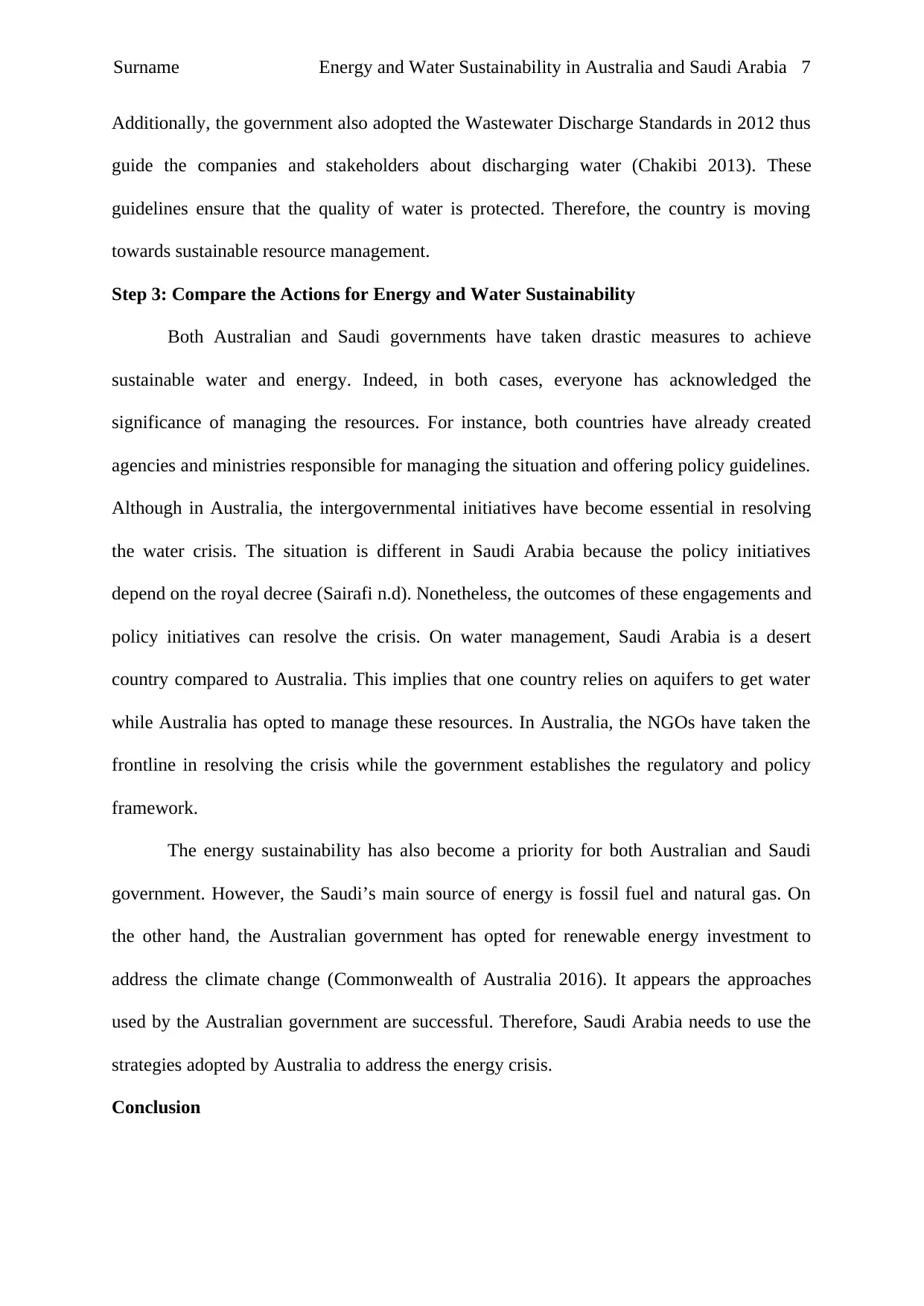
Surname Energy and Water Sustainability in Australia and Saudi Arabia 7
Additionally, the government also adopted the Wastewater Discharge Standards in 2012 thus
guide the companies and stakeholders about discharging water (Chakibi 2013). These
guidelines ensure that the quality of water is protected. Therefore, the country is moving
towards sustainable resource management.
Step 3: Compare the Actions for Energy and Water Sustainability
Both Australian and Saudi governments have taken drastic measures to achieve
sustainable water and energy. Indeed, in both cases, everyone has acknowledged the
significance of managing the resources. For instance, both countries have already created
agencies and ministries responsible for managing the situation and offering policy guidelines.
Although in Australia, the intergovernmental initiatives have become essential in resolving
the water crisis. The situation is different in Saudi Arabia because the policy initiatives
depend on the royal decree (Sairafi n.d). Nonetheless, the outcomes of these engagements and
policy initiatives can resolve the crisis. On water management, Saudi Arabia is a desert
country compared to Australia. This implies that one country relies on aquifers to get water
while Australia has opted to manage these resources. In Australia, the NGOs have taken the
frontline in resolving the crisis while the government establishes the regulatory and policy
framework.
The energy sustainability has also become a priority for both Australian and Saudi
government. However, the Saudi’s main source of energy is fossil fuel and natural gas. On
the other hand, the Australian government has opted for renewable energy investment to
address the climate change (Commonwealth of Australia 2016). It appears the approaches
used by the Australian government are successful. Therefore, Saudi Arabia needs to use the
strategies adopted by Australia to address the energy crisis.
Conclusion
Additionally, the government also adopted the Wastewater Discharge Standards in 2012 thus
guide the companies and stakeholders about discharging water (Chakibi 2013). These
guidelines ensure that the quality of water is protected. Therefore, the country is moving
towards sustainable resource management.
Step 3: Compare the Actions for Energy and Water Sustainability
Both Australian and Saudi governments have taken drastic measures to achieve
sustainable water and energy. Indeed, in both cases, everyone has acknowledged the
significance of managing the resources. For instance, both countries have already created
agencies and ministries responsible for managing the situation and offering policy guidelines.
Although in Australia, the intergovernmental initiatives have become essential in resolving
the water crisis. The situation is different in Saudi Arabia because the policy initiatives
depend on the royal decree (Sairafi n.d). Nonetheless, the outcomes of these engagements and
policy initiatives can resolve the crisis. On water management, Saudi Arabia is a desert
country compared to Australia. This implies that one country relies on aquifers to get water
while Australia has opted to manage these resources. In Australia, the NGOs have taken the
frontline in resolving the crisis while the government establishes the regulatory and policy
framework.
The energy sustainability has also become a priority for both Australian and Saudi
government. However, the Saudi’s main source of energy is fossil fuel and natural gas. On
the other hand, the Australian government has opted for renewable energy investment to
address the climate change (Commonwealth of Australia 2016). It appears the approaches
used by the Australian government are successful. Therefore, Saudi Arabia needs to use the
strategies adopted by Australia to address the energy crisis.
Conclusion
Paraphrase This Document
Need a fresh take? Get an instant paraphrase of this document with our AI Paraphraser
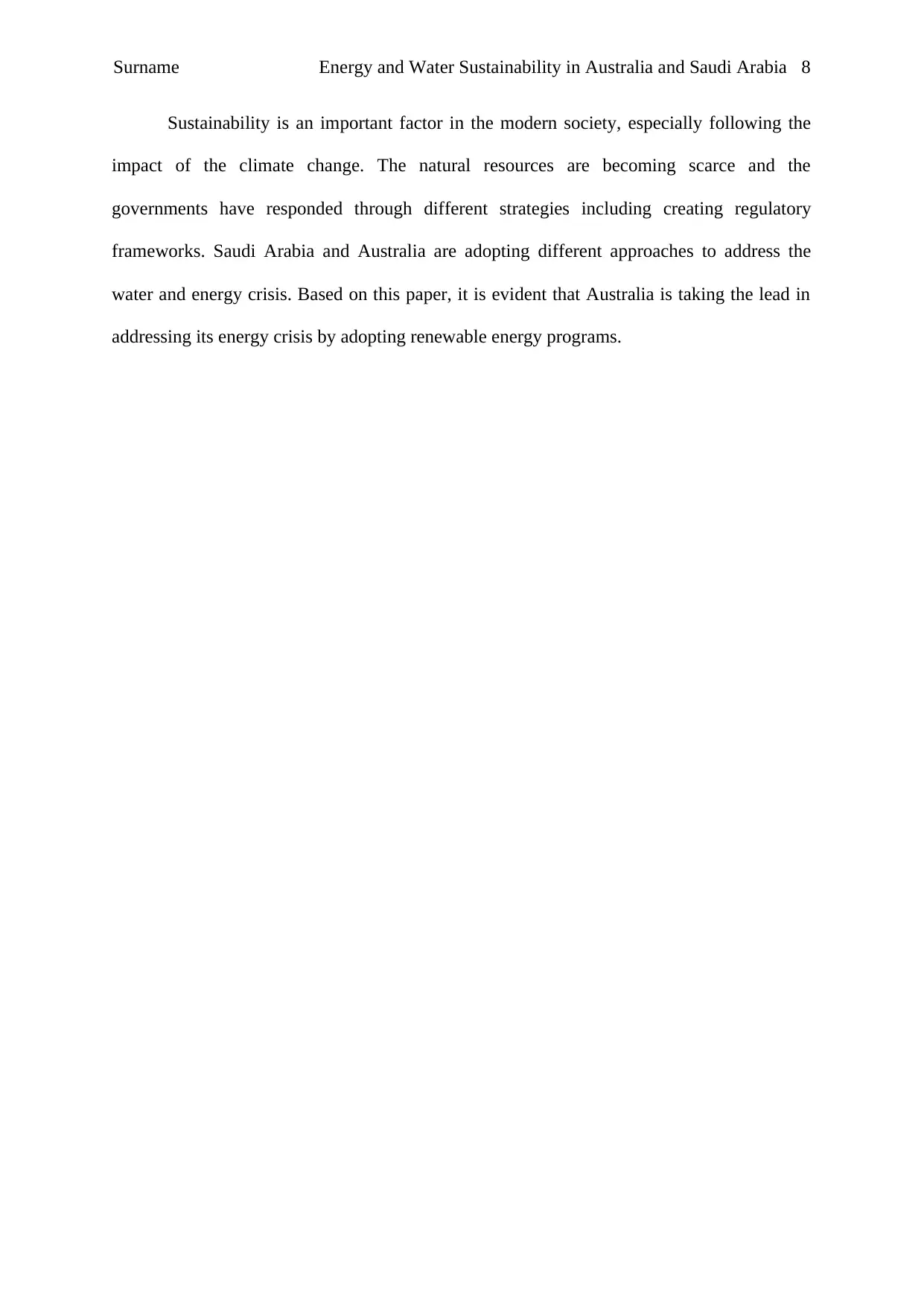
Surname Energy and Water Sustainability in Australia and Saudi Arabia 8
Sustainability is an important factor in the modern society, especially following the
impact of the climate change. The natural resources are becoming scarce and the
governments have responded through different strategies including creating regulatory
frameworks. Saudi Arabia and Australia are adopting different approaches to address the
water and energy crisis. Based on this paper, it is evident that Australia is taking the lead in
addressing its energy crisis by adopting renewable energy programs.
Sustainability is an important factor in the modern society, especially following the
impact of the climate change. The natural resources are becoming scarce and the
governments have responded through different strategies including creating regulatory
frameworks. Saudi Arabia and Australia are adopting different approaches to address the
water and energy crisis. Based on this paper, it is evident that Australia is taking the lead in
addressing its energy crisis by adopting renewable energy programs.
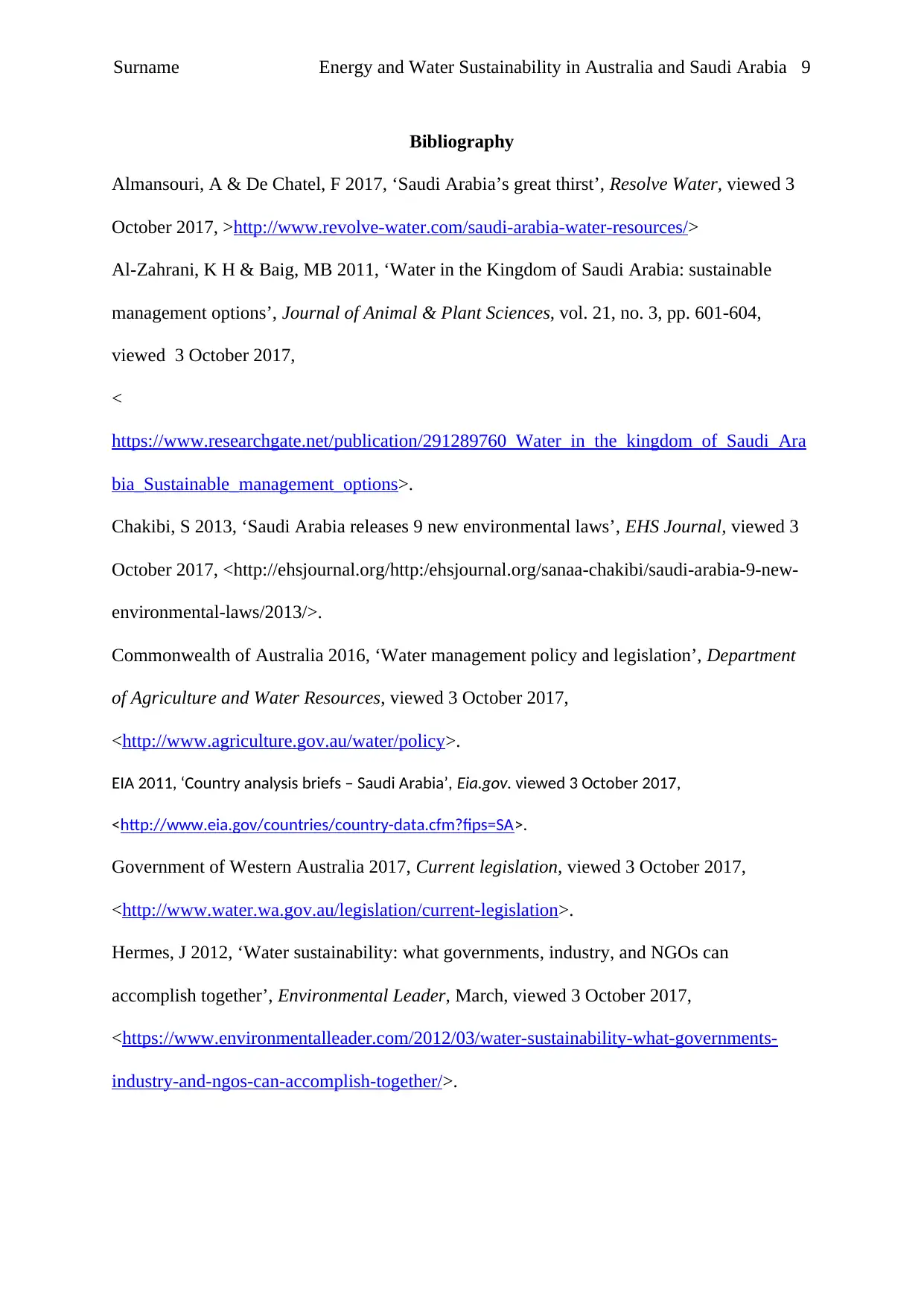
Surname Energy and Water Sustainability in Australia and Saudi Arabia 9
Bibliography
Almansouri, A & De Chatel, F 2017, ‘Saudi Arabia’s great thirst’, Resolve Water, viewed 3
October 2017, >http://www.revolve-water.com/saudi-arabia-water-resources/>
Al-Zahrani, K H & Baig, MB 2011, ‘Water in the Kingdom of Saudi Arabia: sustainable
management options’, Journal of Animal & Plant Sciences, vol. 21, no. 3, pp. 601-604,
viewed 3 October 2017,
<
https://www.researchgate.net/publication/291289760_Water_in_the_kingdom_of_Saudi_Ara
bia_Sustainable_management_options>.
Chakibi, S 2013, ‘Saudi Arabia releases 9 new environmental laws’, EHS Journal, viewed 3
October 2017, <http://ehsjournal.org/http:/ehsjournal.org/sanaa-chakibi/saudi-arabia-9-new-
environmental-laws/2013/>.
Commonwealth of Australia 2016, ‘Water management policy and legislation’, Department
of Agriculture and Water Resources, viewed 3 October 2017,
<http://www.agriculture.gov.au/water/policy>.
EIA 2011, ‘Country analysis briefs – Saudi Arabia’, Eia.gov. viewed 3 October 2017,
<http://www.eia.gov/countries/country-data.cfm?fips=SA>.
Government of Western Australia 2017, Current legislation, viewed 3 October 2017,
<http://www.water.wa.gov.au/legislation/current-legislation>.
Hermes, J 2012, ‘Water sustainability: what governments, industry, and NGOs can
accomplish together’, Environmental Leader, March, viewed 3 October 2017,
<https://www.environmentalleader.com/2012/03/water-sustainability-what-governments-
industry-and-ngos-can-accomplish-together/>.
Bibliography
Almansouri, A & De Chatel, F 2017, ‘Saudi Arabia’s great thirst’, Resolve Water, viewed 3
October 2017, >http://www.revolve-water.com/saudi-arabia-water-resources/>
Al-Zahrani, K H & Baig, MB 2011, ‘Water in the Kingdom of Saudi Arabia: sustainable
management options’, Journal of Animal & Plant Sciences, vol. 21, no. 3, pp. 601-604,
viewed 3 October 2017,
<
https://www.researchgate.net/publication/291289760_Water_in_the_kingdom_of_Saudi_Ara
bia_Sustainable_management_options>.
Chakibi, S 2013, ‘Saudi Arabia releases 9 new environmental laws’, EHS Journal, viewed 3
October 2017, <http://ehsjournal.org/http:/ehsjournal.org/sanaa-chakibi/saudi-arabia-9-new-
environmental-laws/2013/>.
Commonwealth of Australia 2016, ‘Water management policy and legislation’, Department
of Agriculture and Water Resources, viewed 3 October 2017,
<http://www.agriculture.gov.au/water/policy>.
EIA 2011, ‘Country analysis briefs – Saudi Arabia’, Eia.gov. viewed 3 October 2017,
<http://www.eia.gov/countries/country-data.cfm?fips=SA>.
Government of Western Australia 2017, Current legislation, viewed 3 October 2017,
<http://www.water.wa.gov.au/legislation/current-legislation>.
Hermes, J 2012, ‘Water sustainability: what governments, industry, and NGOs can
accomplish together’, Environmental Leader, March, viewed 3 October 2017,
<https://www.environmentalleader.com/2012/03/water-sustainability-what-governments-
industry-and-ngos-can-accomplish-together/>.
⊘ This is a preview!⊘
Do you want full access?
Subscribe today to unlock all pages.

Trusted by 1+ million students worldwide
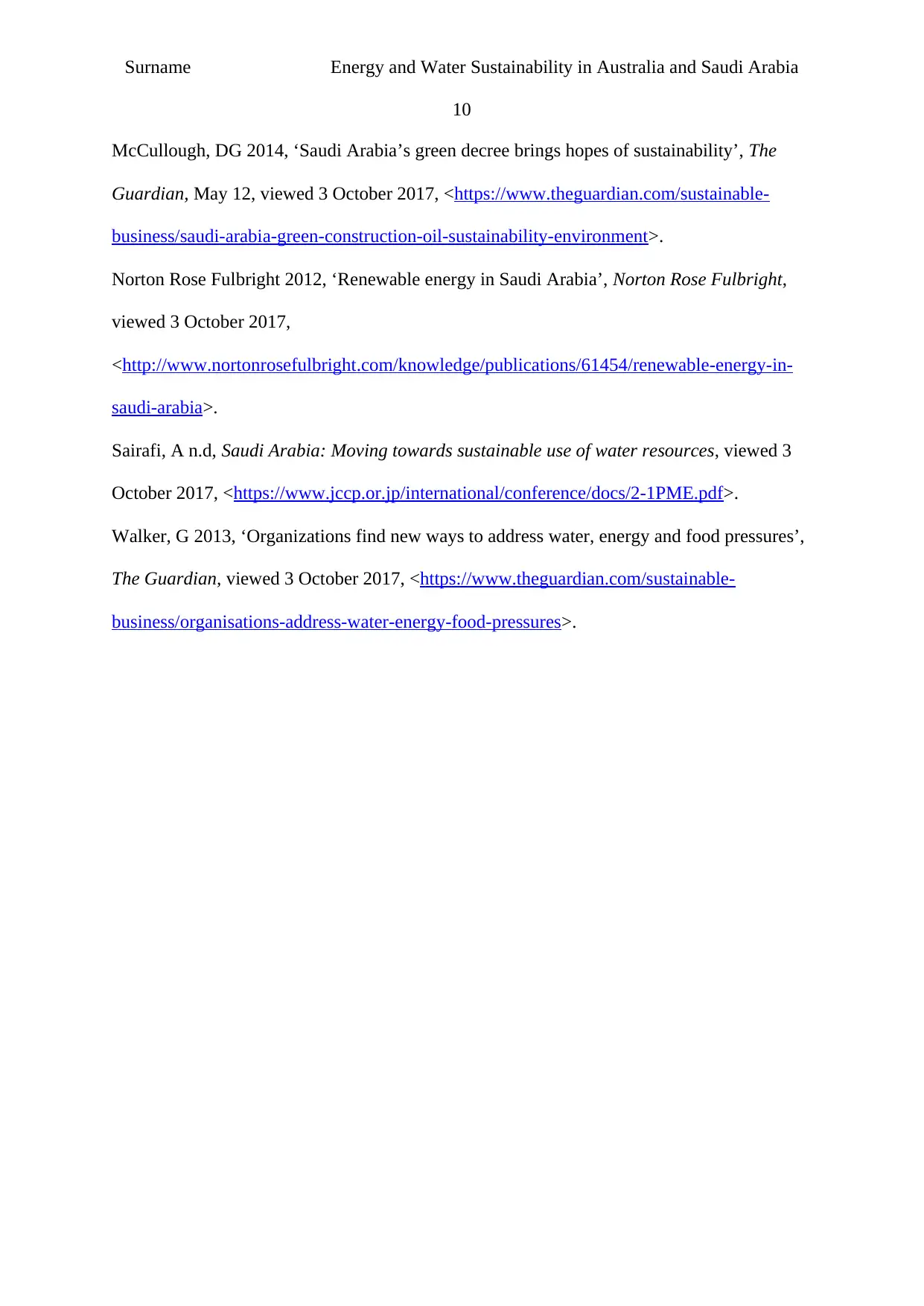
Surname Energy and Water Sustainability in Australia and Saudi Arabia
10
McCullough, DG 2014, ‘Saudi Arabia’s green decree brings hopes of sustainability’, The
Guardian, May 12, viewed 3 October 2017, <https://www.theguardian.com/sustainable-
business/saudi-arabia-green-construction-oil-sustainability-environment>.
Norton Rose Fulbright 2012, ‘Renewable energy in Saudi Arabia’, Norton Rose Fulbright,
viewed 3 October 2017,
<http://www.nortonrosefulbright.com/knowledge/publications/61454/renewable-energy-in-
saudi-arabia>.
Sairafi, A n.d, Saudi Arabia: Moving towards sustainable use of water resources, viewed 3
October 2017, <https://www.jccp.or.jp/international/conference/docs/2-1PME.pdf>.
Walker, G 2013, ‘Organizations find new ways to address water, energy and food pressures’,
The Guardian, viewed 3 October 2017, <https://www.theguardian.com/sustainable-
business/organisations-address-water-energy-food-pressures>.
10
McCullough, DG 2014, ‘Saudi Arabia’s green decree brings hopes of sustainability’, The
Guardian, May 12, viewed 3 October 2017, <https://www.theguardian.com/sustainable-
business/saudi-arabia-green-construction-oil-sustainability-environment>.
Norton Rose Fulbright 2012, ‘Renewable energy in Saudi Arabia’, Norton Rose Fulbright,
viewed 3 October 2017,
<http://www.nortonrosefulbright.com/knowledge/publications/61454/renewable-energy-in-
saudi-arabia>.
Sairafi, A n.d, Saudi Arabia: Moving towards sustainable use of water resources, viewed 3
October 2017, <https://www.jccp.or.jp/international/conference/docs/2-1PME.pdf>.
Walker, G 2013, ‘Organizations find new ways to address water, energy and food pressures’,
The Guardian, viewed 3 October 2017, <https://www.theguardian.com/sustainable-
business/organisations-address-water-energy-food-pressures>.
1 out of 10
Related Documents
Your All-in-One AI-Powered Toolkit for Academic Success.
+13062052269
info@desklib.com
Available 24*7 on WhatsApp / Email
![[object Object]](/_next/static/media/star-bottom.7253800d.svg)
Unlock your academic potential
Copyright © 2020–2025 A2Z Services. All Rights Reserved. Developed and managed by ZUCOL.





